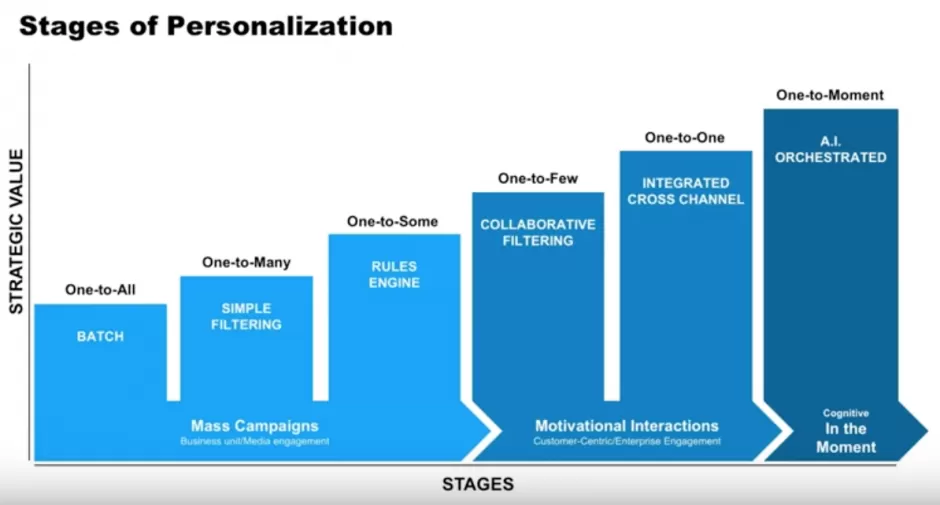Personalisation is a term increasingly used in digital marketing, and for good reason — it effectively improves customer engagement, which drives revenue. For media companies, that means more revenues from advertising and subscription services.
Although most companies acknowledge the advantage of personalisation, 80 % fail at using the strategy effectively. In the media and entertainment (M&E) industry, keeping pace with the innovation consumers expect means that brands must get personalisation right. They must provide targeted, customer-centric, cross-channel, consistent experiences to grow and retain their audiences and to drive digital revenues. This sets the bar for anticipated experience across ecommerce if it wasn’t obvious.
Most media companies are already keenly aware they must move in this direction. Companies use personalised content to create more connected experiences with consumers. Companies that have successfully incorporated personalisation are seeing results. Forbes’ “Publish or Perish” report says that digital marketers who provide personalisation on their websites are getting double-digit returns on their marketing campaign performance and response. Alas, the penny is yet to drop for many ecommerce retailers.
The move toward personalisation isn’t a trend, but an undeniable shift that requires brands to act, not just react. To meet this challenge, companies must use technology solutions like data management platforms and cloud-based solutions to develop a deeper knowledge of their customer segments, how to find and target the most valuable customers, and how to place audience centricity at the heart of their business and growth strategies.

Growth strategies for companies
Select the right Technology. Technological advances such as direct-to-consumer services, advanced advertising, and audience-based DMPs created new opportunities for companies to grow and reach their audiences. There is no need to wait or lament over missing one’s favourite brands or products.
Consumers now can take them on their phones and tablets, and expect every platform to offer the same great experiences on the go as are available at home. Wearable technology is poised to be an important part of the Internet of Things, interacting seamlessly with other screens and devices and creating ever-more personalised experiences for their owners.
Provide more content. With an increased capacity for alternate distribution options, more and more content is created and delivered on every glass. Whether it’s articles, blogs or videos on websites, WordPress users publish 347 new products per minute. With so much information available, it is difficult for brands to stand out and to get their message to their target audience.
Exceed consumer expectations. With the avalanche of content and technological advances, consumers can hold their selections in their hands. Because of the plethora of options, consumers can afford to be selective. And they are. If a customer has a bad experience with a brand, they don’t hesitate to tell their 500 closest Facebook friends about it or to crowdsource to get recommendations for a replacement.
Ironically, a good customer experience presents challenges, too — when consumers have a positive experience with one brand, they expect that level of experience in all future interactions, with all brands.
These changes in the brand-consumer relationship affect all industries, from fashion to grocery to business services. The age of the customer is here. Consumers are now firmly in the driver’s seat, with access to more information and choices than ever before.
The need for personalisation
Consumers seek personalisation. Given this dynamically changing landscape, brands must change how they interact with customers to engage with them, and personalisation is key. Instead of providing consumers with what brands decide the consumers should have, brands must determine what consumers want, and deliver that product or information when the consumer wants it, via the method the consumer wants to receive it.
“We’re bombarded with so many devices, mediums, shows, books, movies, and albums to choose from, it’s almost overwhelming,” says Mike Brown, CEO of Fision, a leading provider of agile marketing software and solutions. “People are seeking better ways to curate the types of products they want .”
Think about searching for a movie on Amazon Prime Video. With over 18,000 movies and nearly 2,000 television shows available, the choices of what to watch on a random Thursday night can be dizzying.
But, when Amazon makes recommendations based on the consumer’s prior viewing or buying history, it makes the selection process easier for the consumer. imagine that in your email content, so wonder SwiftERM product selection personalisation software is a must-have for all ecommerce sites, in addition to their ESP software, from the finest to the biggest.
Creating that focused offering makes it easier for customers to buy, Mike says. He buys 12 audiobooks a year through a subscription to Amazon.
“I’m mostly buying the books they recommend based on my Kindle purchase. They’ve created this system where they know what I like to read in physical form so they then show me similar content.” In addition to providing recommendations, the content is available on multiple devices, in paper, digital, or audio form.

Brands must provide personalisation. Consumers enjoy a personalised ecommerce experience. To paraphrase an old saying, “If the consumer ain’t happy, ain’t nobody happy!” In other words, when consumers have a positive experience, everyone wins.
Consumers are more likely to be repeat customers, and it costs significantly less to keep a repeat customer than to win over a new one. Even better — loyal customers spend more money. In the U.S. 8 % of repeat customers account for 40 % of revenue.
Brands using personalisation see revenue increase 6 – 10 % — two to three times faster than brands that don’t use personalisation. The Boston Consulting Group forecasts that in the next five years in the retail, health care, and financial services industries, $800 billion in revenue will shift to the 15 % of companies that get personalisation right.
These statistics highlight the gains brands get with personalisation. It seems intuitive that businesses would fully commit to being part of that 15 %. But that’s not the case.
What is the future of content personalisation?
Brendan Witcher, principal analyst at Forrester, recently said the next step beyond personalisation is individualisation — developing a rich collection of data that forms a more accurate picture of the customer. To be successful, the data must come from multiple sources — systems that are traditionally siloed in companies, he says. Ideally, companies won’t deliver what feels like personalisation. Instead, Brendan says, it will just feel like a great customer experience.
The complexities from the age of the consumer are not going away. Media companies must use all the tools and technologies available to them to develop a genuinely customer-centric focus.
Companies that employ technology effectively to identify, understand, and provide highly personalised experiences to their customers with engaging content will succeed, while those that hesitate to fully embrace personalisation will be left behind.





